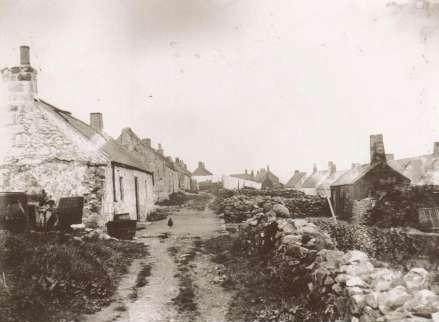
A Fisher's Life in the 1890's |
I would like to acknowledge Stuart Christie for pointing me in the right direction to find this report and also to Philippa Crabbe who transcribed this work.
Fisher life and habits in relation to disease, with special reference to the question of intermarriage (An M.D. Thesis by Robert Haldane Cook, M.D., C.M. Portlethen Law Library, University of Aberdeen, 1895).
Fisher Life in the 1890ís
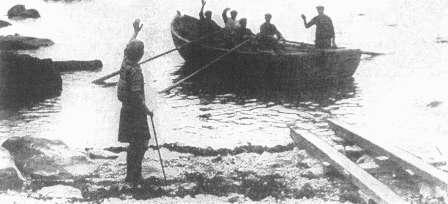 The
writer, until recently held the universally accepted opinion that
marriage between cousins was responsible in many cases for insanity,
lack of intelligence, poor physique, and albinism. For the past two and
a half years however, he has had excellent opportunities of observing a
small community of about 340 people, where inter-marriage has been a
custom handed down from father to son, and his observations have led him
to change his opinion entirely, so far as this community is concerned.
With regard their life and habits, the following pages go to show that
though the sanitary arrangements are of a most rudimentary kind, yet,
for various reasons, the general health is most satisfactory. The writer
has been absolutely the sole medical attendant of this community for the
past two and a half years.
The
writer, until recently held the universally accepted opinion that
marriage between cousins was responsible in many cases for insanity,
lack of intelligence, poor physique, and albinism. For the past two and
a half years however, he has had excellent opportunities of observing a
small community of about 340 people, where inter-marriage has been a
custom handed down from father to son, and his observations have led him
to change his opinion entirely, so far as this community is concerned.
With regard their life and habits, the following pages go to show that
though the sanitary arrangements are of a most rudimentary kind, yet,
for various reasons, the general health is most satisfactory. The writer
has been absolutely the sole medical attendant of this community for the
past two and a half years.
Situation
The fishing village of Portlethen, of which this thesis treats, lies on
the coast of Kincardineshire, about eight miles distant from the towns
of Aberdeen and Stonehaven. It is triangular in shape with the base to
the sea. It lies on a considerable slope, the first house being 100 feet
and the last, 160 feet above the sea level. The houses are built in rows
across the slope facing the sea, and are nearly all joined on to each
other, only a few being detached. The distance between the rows varies
from 40 to 90 feet, and between some of the rows there are small garden
plots, and an occasional wooden house, in which the fish are smoked.
There are 17 houses, 6 being vacant. The streets or roads are of the
most rudimentary description. Between the months of October and April,
they are simply mud with stones of various sizes sticking up through it.
The back wall of a row of houses rises out of a ditch varying in depth
from l to 6
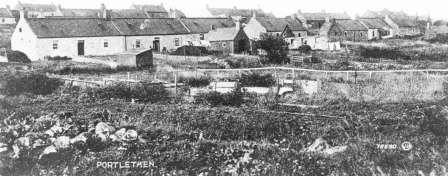 feet.
During wet weather, the rain water gathers in these ditches and as they
have no drains, it remains there for a considerable time, gradually
sinking into the ground. Each house is provided with a midden into which
all the refuse, including water, is poured. Most of these middens are
between the rows of houses, so that the water from them finds its way by
gravitation into the ditches at the back of the next row. Most of the
household water is however thrown right out at the door.
feet.
During wet weather, the rain water gathers in these ditches and as they
have no drains, it remains there for a considerable time, gradually
sinking into the ground. Each house is provided with a midden into which
all the refuse, including water, is poured. Most of these middens are
between the rows of houses, so that the water from them finds its way by
gravitation into the ditches at the back of the next row. Most of the
household water is however thrown right out at the door.
Drainage
The drainage of the village is very primitive. There are two drains. The main drain runs from the top of the village down the centre, taking the course of one of the roads. It is built of stone and lime, is 18" square and is 6 ft. from the surface. It is in good working order. Into this main drain channels run from between the various rows of houses. These channels are about 3" deep and are open. They end, some in iron branders, others in a hole which communicates with the drain. But they enter very slightly into the lives of the inhabitants, for as we have seen, they mostly fling their liquid refuse either into the middens, or straight out at the door. The other drain runs on the north side of the village from in front of the highest row of houses. It is about 12" below the surface and being built without lime, is frequently choked. There are channels run into this drain from between the rows of houses just as in the case of the main drain. Both drains discharge their contents separately, 20 yards in front of the first row of houses, at an altitude of 95 feet from the sea level. The drainage then finds its way over grassy cliffs down to the sea.
Soil
The soil is generally speaking, clayey with occasionally patches of gravel, the whole resting on a basis of hardpan.
Temperature
Mean annual-F 45; Summer mean -F 58; Winter mean -F 37
Rainfall
Mean annual -32.5 in. with 193 wet days on the average
Winds
The village has no shelter of any kind, and is exposed to the full force of every wind that blows. No one wind is particularly prevalent, but as a general rule, more winds come off the sea than off the land.
Privies and Middens
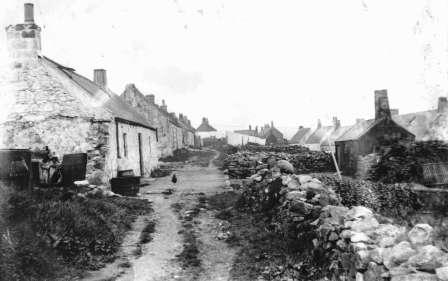 Such
a thing as a privy is unknown. There never has been one in the village.
The men deposit their excrement all round the outskirts of the town,
according to where their houses are situated. Some go over the walls on
either side of the village, while some go to the cliffs in front or on
either side of it, with the result that the immediate vicinity is in a
disgusting state. According to the weather and the time of day or night,
the women follow the example of the men, or else throw their excrement
from a pail into the middens. The children are even less fastidious then
their parents with consequent defilement of the streets, more especially
about the doors. There is no scavenger in the village and individuals do
not attempt to supply his place. The middens which contain household
refuse, human excrement and fish offal, are emptied by various farmers
who come at their own convenience, so that a midden is often full to
overflowing. Some of the men pay almost the whole of their rent from the
produce of their middens.
Such
a thing as a privy is unknown. There never has been one in the village.
The men deposit their excrement all round the outskirts of the town,
according to where their houses are situated. Some go over the walls on
either side of the village, while some go to the cliffs in front or on
either side of it, with the result that the immediate vicinity is in a
disgusting state. According to the weather and the time of day or night,
the women follow the example of the men, or else throw their excrement
from a pail into the middens. The children are even less fastidious then
their parents with consequent defilement of the streets, more especially
about the doors. There is no scavenger in the village and individuals do
not attempt to supply his place. The middens which contain household
refuse, human excrement and fish offal, are emptied by various farmers
who come at their own convenience, so that a midden is often full to
overflowing. Some of the men pay almost the whole of their rent from the
produce of their middens.
Water
The water supply is plentiful and good, coming to a cistern at the top of the village from the hill behind it. There are four pumps in the main streets.
Interiors
Within doors, things are much more pleasant. Except where drunken or thriftless habits prevail, the interiors of the houses are marvels of cleanliness; and this is more striking when one considers the state of things around the very doors. Three times a year everything is taken outside and cleaned, in the most thorough manner, while the interior of the house is treated with soap and water or whitewashed, as the case may be. The woodwork in the better class houses is left unpainted and is scrubbed with soft soap and sand, so that in a few years it gains a most beautiful polish. Even the rafters are so treated. Once a week the houses are cleaned and every other day all about the fireplace is whitewashed. The outside walls of most of the houses are also frequently whitewashed.
%20-%201.jpg) Such
a state of affairs is not found in every house, and a small minority of
them are as remarkable for filth as the majority are for cleanliness.
The houses themselves are mostly old and thatched, the newer ones being
slated and rather larger than the old ones. They are all very draughty,
none of them having porches, while as often as not, the door has to be
left open to make the fire draw. All the houses consist of two rooms - a
"but" and a "ben" with a loft above, where nets, oars etc., are kept.
The family live and carry on their work in the "but" end, and here they
clean fish and bait their lines, except during the summer months.
Such
a state of affairs is not found in every house, and a small minority of
them are as remarkable for filth as the majority are for cleanliness.
The houses themselves are mostly old and thatched, the newer ones being
slated and rather larger than the old ones. They are all very draughty,
none of them having porches, while as often as not, the door has to be
left open to make the fire draw. All the houses consist of two rooms - a
"but" and a "ben" with a loft above, where nets, oars etc., are kept.
The family live and carry on their work in the "but" end, and here they
clean fish and bait their lines, except during the summer months.
In many houses they also smoke fish in a large open chimney at the side of the ordinary one. Some have smoking houses for this purpose. In many of the newer houses the floor in the "but" end is wooden, but in most cases it is earthen. There is one box-bed in this room. In the other room, or "ben" end, there is always a wooden floor and from one to three box-beds, according to the size of the family. This is the principal sleeping room and is always used as the lying-in room.
Personal Cleanliness
It is a matter of common observation that fishers, both men and women are as a rule, very clean and tidy in their personal appearance. One reason of course is that their market depends quite as much on their own appearance as on that of their fish.
Light and Firing
It is about thirty years since the last "cruisie" was burnt with its spluttering light and stinking flame. Instead of the pith of a rush and fish oil, we find good paraffin lamps and occasionally candles. Peat is the universal fuel, the village being about a mile from a peat moss. The peats are burnt on the open hearth stone above which is a large chimney occupying one third of the end of the house. Coal is seldom used.
Clothing
Fishers as a class may be said to wear more clothing than ordinary people and those in the village of Portlethen bear out the statement.
 The
men always wear flannel next to the skin, above that, one, two or three
ordinary cotton shirts, and then the distinctive garment of the
fisherman - the surcoat. This is a shirt which opens all the way down
the front. It is made of coarse blue serge. On the legs they wear thick
flannel drawers - one or more pairs, according to their thickness, or
the season of the year. Their trousers are of heavy blue cloth. At sea
they wear long waterproof leather boots which reach the hips and their
costume is completed by a double breasted waistcoat with sleeves, of
similar material to the trousers. They always discard this garment when
at work on the oars, or the lines, but resume it again when sailing. One
or two of the old men still adhere to the fashion of their youth, and
instead of flannel drawers wear tailor-made knee breeches of blue cloth.
In warm weather one sees them going about the village in this
picturesque attire, having left off their trousers.
The
men always wear flannel next to the skin, above that, one, two or three
ordinary cotton shirts, and then the distinctive garment of the
fisherman - the surcoat. This is a shirt which opens all the way down
the front. It is made of coarse blue serge. On the legs they wear thick
flannel drawers - one or more pairs, according to their thickness, or
the season of the year. Their trousers are of heavy blue cloth. At sea
they wear long waterproof leather boots which reach the hips and their
costume is completed by a double breasted waistcoat with sleeves, of
similar material to the trousers. They always discard this garment when
at work on the oars, or the lines, but resume it again when sailing. One
or two of the old men still adhere to the fashion of their youth, and
instead of flannel drawers wear tailor-made knee breeches of blue cloth.
In warm weather one sees them going about the village in this
picturesque attire, having left off their trousers.
The women wear a white cotton chemise next to the skin, stays, two or more jackets of cloth, a knitted jacket, and a small shawl around their neck and shoulders. In cold weather they add another shawl which they wear round the head. Only a few of the older women wear the white caps or "mutches". None of them wear drawers of any kind, but always a white flannel petticoat, above which they wear two or three skirts of heavy blue serge. The top one is generally "kilted", a custom peculiar to fisherwomen. The children are clad in much the same way as their parents, but there is a growing tendency to use ready-made clothing which is very much inferior to the splendid blue -serge and blue cloth which the older people wear.
A small percentage of the younger men, and nearly all the girls and younger women, on a Sunday, wear clothes similar to those of their neighbours in the country, thus losing their celebrated picturesqueness. It is a fact worthy of notice however that directly the morning service is over, they once more resume their distinctive clothing.
Food and Drink
During about five months of the year, (at the Banks and the Herring Fishing), the men live chiefly on tea, loaf-bread and oatcakes. They usually come home at each week-end and are then better cared for. During the rest of the year they consume large quantities of small fish and potatoes, and a certain amount of butcher meat and farinaceous foods. Many drink cocoa and coffee as well as tea.
In the matter of alcohol, they are not a very abstemious race. When money is plentiful and often when it is not, the women (being the purse-bearers), bring home a pint of rum or whisky, once or twice a week. Some of the men and one or two of the women, seldom come home from the town sober. There is also a shop in the village where porter and ale may be had, and especially of a Saturday night the trade is very brisk.
Education
,%20Wm%20Craig,%20Ondy%20Craig.jpg) Fisher
children are by no means behind ordinary country children in point of
intelligence, while their facilities for home study are not so good. The
evening is usually the busiest time in fisher houses - cleaning and
baiting the lines - and the children are called upon to lend a helping
hand. Yet the results of examination shows that the fisher children make
quite as good an appearance as the other scholars. At present there are
four lads, who so far as far as theory is concerned, are quite able to
pass the Board of Trade examination for Second Mate.
Fisher
children are by no means behind ordinary country children in point of
intelligence, while their facilities for home study are not so good. The
evening is usually the busiest time in fisher houses - cleaning and
baiting the lines - and the children are called upon to lend a helping
hand. Yet the results of examination shows that the fisher children make
quite as good an appearance as the other scholars. At present there are
four lads, who so far as far as theory is concerned, are quite able to
pass the Board of Trade examination for Second Mate.
Physique
The inhabitants of Portlethen village are of quite a superior physique. Most of the women are decidedly above the average height, while no less than seventeen of the men are 6 ft. and over, one man being 6 ft 6 ins. They are decidedly well developed and possess splendid constitutions; One would expect this from the nature of their calling. The women have, as a rule, very roomy pelves, this being due no doubt partly to heredity and partly to the fact that they are accustomed to carrying from early girlhood onwards, heavy burdens in their creels, which rest on the sacrum. They carry the fish from the harbour to the houses (up a very steep hill) and from the village to the railway station - nearly a mile. Many of them carry a year's supply of peats home from the moss in their creels. It is no uncommon thing for a young girl to carry a creel one and a half cwts. in weight, or more. The fact remains that their confinements are usually easy, instrumental aid being seldom required.
Marriage
.jpg) Most
of the young men marry between the ages of 22 and 25, their wives being
usually one or more years younger. There is one bachelor over 70 years
of age, all others being under 30, and not likely to remain long
unmarried. But there are a number of unmarried women of more than 30
years of age. Ante-nuptial cohabitation is almost invariable, and about
half of the wedded couples begin married life with one, two and (very
occasionally) three children. But such a thing as loose immorality is
unknown in the village, the father and mother always marry sooner or
later. There is only one inhabitant of over five years of age whose
parents were unmarried and this was owing to the father being drowned at
sea. Thus it will be seen that morality is at a much higher level than
in either town or country. Perhaps the explanation lies to a certain
extent in the fact that children are more or less a source of gain to a
fisher. The sons go to sea with their father, allowing him to take a
larger share in a boat, and consequently to get a larger share of fish,
while the daughters help to clean and sell them. Neither sons nor
daughters are paid for their services. Many of the younger married
couples have to employ a servant to help them. The first child is
frequently born to parents who are both under 20 years of age. In spite
of this, the families are not large and last census the number of
inmates per house averages only five. A family of seven or eight is
considered a big one.
Most
of the young men marry between the ages of 22 and 25, their wives being
usually one or more years younger. There is one bachelor over 70 years
of age, all others being under 30, and not likely to remain long
unmarried. But there are a number of unmarried women of more than 30
years of age. Ante-nuptial cohabitation is almost invariable, and about
half of the wedded couples begin married life with one, two and (very
occasionally) three children. But such a thing as loose immorality is
unknown in the village, the father and mother always marry sooner or
later. There is only one inhabitant of over five years of age whose
parents were unmarried and this was owing to the father being drowned at
sea. Thus it will be seen that morality is at a much higher level than
in either town or country. Perhaps the explanation lies to a certain
extent in the fact that children are more or less a source of gain to a
fisher. The sons go to sea with their father, allowing him to take a
larger share in a boat, and consequently to get a larger share of fish,
while the daughters help to clean and sell them. Neither sons nor
daughters are paid for their services. Many of the younger married
couples have to employ a servant to help them. The first child is
frequently born to parents who are both under 20 years of age. In spite
of this, the families are not large and last census the number of
inmates per house averages only five. A family of seven or eight is
considered a big one.
Inter-marriage
Marriage between cousins is a custom which has been handed down from father to son. There are at present no less than nine first cousins married to each other, while one couple are first cousins on both sides - that is, the woman's father is the man's uncle and the man's mother is the woman's aunt. This represents almost one fifth of the married couples. Many have the idea that it is not a fair or proper thing to get a wife elsewhere while a cousin remains unmarried. This custom of intermarriage has gone on for ages, and as there are no importations of men (every man in the village was born in it), the only new blood that enters the community is when a man takes a wife from another fishing village. This is sometimes done, but by far the greater number marry natives of the village. Thus it will readily be understood that the majority of the inhabitants are blood relations to each other.
Disease
.jpg) The
population of the village of Portlethen is a wonderfully healthy one in
spite of its insanitary condition, and in spite of the extent of
intermarriage amongst its inhabitants. Their ailments are neither
remarkable nor characteristic, in fact sickness is a more or less
uncommon event. The population for the last two and a half years has
stood at about 340. During that time there have been twelve deaths, six
persons being above the age of 60 years, and five of those being above
70.
The
population of the village of Portlethen is a wonderfully healthy one in
spite of its insanitary condition, and in spite of the extent of
intermarriage amongst its inhabitants. Their ailments are neither
remarkable nor characteristic, in fact sickness is a more or less
uncommon event. The population for the last two and a half years has
stood at about 340. During that time there have been twelve deaths, six
persons being above the age of 60 years, and five of those being above
70.
The average duration of life was 44.16 years and the death rate about 14 per 1,000. And there is little doubt that the old folk would reach a much greater age if they were properly cared for when ill. When any of the old folk fall ill, medical aid is usually sought, but the all important point seems to be - is the illness likely to be fatal? Medicines and even food are not administered with anything like regularity. Sometimes a hopeful prognosis is received with distinct disfavour. This is the more to be wondered at as at ordinary times there is no lack of affection in the members of a family for their parents.
During this period of two and a half years there have been no cases of Haemoptysis, Phthisis, Bone disease or Tubercular disease of any kind. Nor have there been any cases of chronic illness.
In August 1893, there was an epidemic which was very suspicious of Typhus Fever, but which was officially diagnosed as "Low Fever". There was one death, The epidemic was confined to three houses. In one all the inmates (7) took it. In another, 3 out of the 5 and in the last, 1 out of 3 took it.
In December 1893, there was a severe epidemic of measles with two deaths. Otherwise, except for accidents and acute illnesses, there is little sickness.
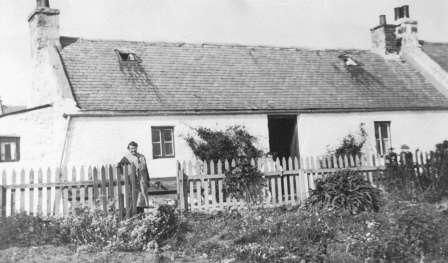 In
temperament, these fishers are a curious mixture of the phlegmatic and
the nervous. When in trouble or in sickness, they show an amount of
fortitude and philosophical calm which is totally different from the
childish excitement they exhibit over any trivial accident. They are
abject cowards in the dark and never go any distance. At night alone;
they have a terror of noises, dogs and guns and have a firm belief in
the supernatural. Indeed, the mere sight or mention of various animals
is enough to turn a man from his day's fishing, on account of the ill
luck it is supposed to bring to the boat. And yet insanity is far from
common, and their mental faculties usually remain clear to the last.
There have been three cases of insanity removed to the asylum during the
last fourteen years (Insp.of Poor). There is one woman of 40 who is
slightly weak minded and one idiot of 7 years of age, both resident in
the village. There is a boy of 12 who has been paralysed since infancy
(of Infantile Paralysis).
In
temperament, these fishers are a curious mixture of the phlegmatic and
the nervous. When in trouble or in sickness, they show an amount of
fortitude and philosophical calm which is totally different from the
childish excitement they exhibit over any trivial accident. They are
abject cowards in the dark and never go any distance. At night alone;
they have a terror of noises, dogs and guns and have a firm belief in
the supernatural. Indeed, the mere sight or mention of various animals
is enough to turn a man from his day's fishing, on account of the ill
luck it is supposed to bring to the boat. And yet insanity is far from
common, and their mental faculties usually remain clear to the last.
There have been three cases of insanity removed to the asylum during the
last fourteen years (Insp.of Poor). There is one woman of 40 who is
slightly weak minded and one idiot of 7 years of age, both resident in
the village. There is a boy of 12 who has been paralysed since infancy
(of Infantile Paralysis).
Conclusions
Here we have to deal with a small population in which we find one or two curious anomalies. First of all there is the marriage of cousins, which has always been very common and is borne out by the fact that at present almost one fifth of the married couples are cousins. Yet there are no albinos in the village, insanity is rare, there is neither scrofula nor rickets, nor, in fact do we find any of the universally accepted results of intermarriage. In their place we find a community where men and women are possessed of a splendid physique along with intelligence of a high order.
It has been shown that the village is always in a most disgusting state
and that the sanitary arrangements are almost entirely in abeyance. The
drainage is quite inadequate, and the careless ways of the people do not
tend to mend matters. The middens at the doors reek of foul odours from
household refuse, human excrement and fish offal. The immediate vicinity
of the village, including the very doorstep, is strewn with feculent
matter. Most of the household slops of one house drain down into
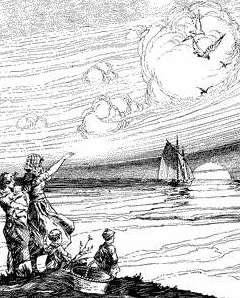 a
ditch at the back of another. The only two drains in the village
discharge their contents over the cliffs, 20 yards from the doors of the
first row of houses. In spite of all this which would depopulate an
inland village, we find a healthy community with a low death rate. What
then are the reasons for this state of matters?
a
ditch at the back of another. The only two drains in the village
discharge their contents over the cliffs, 20 yards from the doors of the
first row of houses. In spite of all this which would depopulate an
inland village, we find a healthy community with a low death rate. What
then are the reasons for this state of matters?
The village is situated on a slope facing the sea, with an exposure to the South East by South, thus getting its full share of sunshine. There is no shelter in any direction from the wind and every breeze which blows has full access to the village. By its close proximity to the sea, the village gets the benefit of the land and sea breezes which are constantly setting one way or the other, owing to the differences in temperature of the sea and the Earth's crust. These sea breezes are laden with ozone, and are free from dust and germs. And here there are more breezes off the sea than off the land.
Again owing to the faulty construction of the middens, the refuse soon lose a great part of its water and this allows the ozone to have better access to the refuse, the organic matters of which it powerfully oxidises. Another important factor is to be found in the huge swarms of rats which inhabit the peat stacks and middens and which eat large quantities of garbage. The writer has seen as many as three dozen turned out of a single peat stack.
 The
houses are not close and stuffy, the rooms being large and draughty with
a capacious chimney. But the inmates are warmly clad and have no idea of
taking off any of their garments on entering a house, the men not even
removing their hats. Their notable cleanliness both in the house and in
their persons, is also greatly in their favour. That there is no
predisposition to Tubercular disease may be safely attributed to the
stock being originally non-tubercular and having been kept so by a
series of inter-marriages, while the arduous nature of their calling,
and their exposure to all sorts of weather naturally tends to harden the
already robust constitutions of the men. We find that the children are
born to parents in their very prime and are therefore better able to
ward off disease. Their water supply is good and taken as a whole, their
food is better than that of the average workman.
The
houses are not close and stuffy, the rooms being large and draughty with
a capacious chimney. But the inmates are warmly clad and have no idea of
taking off any of their garments on entering a house, the men not even
removing their hats. Their notable cleanliness both in the house and in
their persons, is also greatly in their favour. That there is no
predisposition to Tubercular disease may be safely attributed to the
stock being originally non-tubercular and having been kept so by a
series of inter-marriages, while the arduous nature of their calling,
and their exposure to all sorts of weather naturally tends to harden the
already robust constitutions of the men. We find that the children are
born to parents in their very prime and are therefore better able to
ward off disease. Their water supply is good and taken as a whole, their
food is better than that of the average workman.
Thus in a case in which the supposed evil effects of inter-marriage ought to be intensified by the insanitary condition of the village, there is found a population with an abnormally low death-rate, exceptionally well developed physique, a high average of duration of life and a remarkable freedom from constitutional diseases of any kind. Against the sanitary disadvantages have been placed the advantages of situation, mode of life, and meteorological conditions. Those two sets of forces thus neutralizing each other, the fact remains that we have a case in which extensive inter-marriage is un-accompanied by any of the evil effects with which it is usually credited.